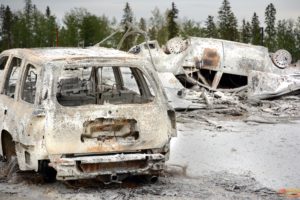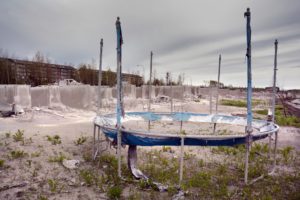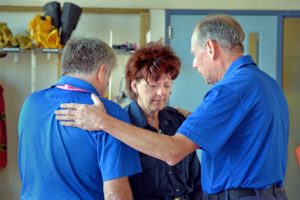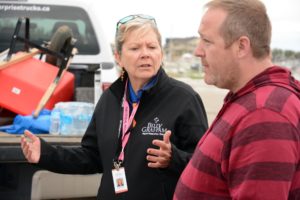As residents returned to their fire-ravaged communities in the northern city of Fort McMurray in early June, they were stunned to see how little remained. Houses were burned to the ground, cars incinerated, playgrounds, schools, restaurants and hotels destroyed, and everything covered in white ash.
“The Fort McMurray fire was so big ─ and burned so hot ─ it created its own climate system,” says Frank King, communications manager for the Billy Graham Evangelistic Association (BGEA) of Canada.
Chaplains from the BGEA’s Rapid Response Team and members of the Samaritan’s Purse Disaster Relief Unit were deployed to Fort McMurray on May 21 and expect to be there until the end of July.
These two faith-based organizations share headquarters in Calgary and work in concert with each other. Samaritan’s Purse, a disaster relief and development agency, brought in heavy equipment to search the remains of homes for valuables. The BGEA Rapid Response Team chaplains, trained for crisis situations, offer emotional and spiritual care for first responders and homeowners.
Fort City Church in Fort McMurray is hosting these two teams, providing both parking for their long trailers and cots for them to sleep on in the church.
“Samaritan’s Purse and the BGEA have been wonderful ─ reaching out in areas we probably couldn’t, even though every one of us thought we could,” explains Fort City Church pastor Phil Sovdi. “In a sense we’re wounded healers, because we have all gone through the trauma ourselves.”
Sovdi, a pastor of adult ministries, has learned that though his vocation is to help others, “sometimes you need to be the one getting the care and the healing.”
Pastors Offer Insight From Past Disasters
On July 13, the Fort McMurray Ministerial Association and the Rapid Response Team (RRT) chaplains brought in pastors from High River and Slave Lake for a one-day conference at Fort City Church. Geared for pastors and others in ministry leadership, the seminars focused on recognizing the signs of trauma and grief as well as detailing what was learned on the road to recovery after the floods in High River and the fire in Slave Lake.
“I think these seminars will help immeasurably,” Sovdi says. “These people have gone through the specifics. They’ve had to process pain and doubt.”
Learning from pastors who have lived through disasters “may stop us from doing something that wouldn’t work,” Sovdi explains.
On July 16, the RRT chaplains put on a day-long seminar for the whole community called Sharing Hope in Crisis.
RRT Manager Merle Doherty explains, “Trauma is unique; it impacts us all differently. This seminar equips people to recognize it and assist those going through it.”
Downtown Firehouse Hit By Fireballs
First responders experienced the most traumatic situations. On May 3, as firefighters fought to save Fort McMurray, fireballs flying from the nearby inferno were landing on the roof of the downtown fire hall. Earlier, worried residents had been bringing their pets to the station. There were animals housed in every room, including two horses.
Dana Allen, the assistant deputy chief of operations and ranking officer, took charge of the station as firefighters drenched the roof with water, saving the building.
In mid-June, two RRT chaplains visited Allen and the other firefighters to thank them for all they had accomplished. Even though thousands of buildings in Fort McMurray were destroyed, there was no loss of life due to the fire.
The RRT chaplains gave Allen a Bible signed by their team and offered to pray for her.
Frank King recounted Allen saying, “Your visit reminded us that we have angels ─ we just sometimes don’t realize they’re here.”
With new teams of 10 chaplains coming each week, by early July they had talked to and cared for over 2800 people, with 16 making first-time decisions to accept Christ into their lives.
Doherty says his chaplains “are extremely encouraged. Although they are physically tired ─ they put in long hours and are sleeping on cots ─ they are still spiritually hungry to spread the gospel.”
In putting together each team of chaplains, Doherty says he has learned the importance of having experienced people together with those who have never worked in disaster zones.
The Fort McMurray wildfire is now considered to be the worst natural disaster to hit Alberta, with over 2,400 structures destroyed and whole neighbourhoods burned to the ground.
Salvation Army There From Start
When the raging fires first crept towards Fort McMurray, the local Salvation Army had already deployed one of their mobile food trucks and was busy feeding firefighters, police and other first responders.
But when the wind shifted suddenly on May 3, the massive inferno raced toward the city causing the evacuation of over 90,000 residents, many fleeing for their lives as the fire lined both sides of Highway 63.
The Salvation Army food truck, also forced to relocate, “pulled over beside the police checkpoint and did what we do best – feed anyone who was around,” says Captain Pam Goodyear, divisional secretary for public relations and development.
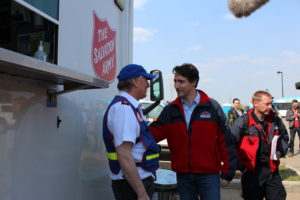
The Prime Minister thanks Major Ron Cartmell (Divisional Commander for Alberta and Northern Territories) for the work of The Salvation Army. Photo by Captain Pam Goodyear, Salvation Army
After decades of responding to disasters, the Salvation Army has learned to quickly assess each situation and make changes according to the needs of those affected.
“We want to be the hands and feet of Jesus,” Goodyear says. “We will fill in whatever gap there is.”
With a strong local presence in the community, the Salvation Army has a church, thrift store, homeless shelter, transitional housing facility and group home, all of which have escaped serious damage in the fire.
“The Salvation Army has been in Fort McMurray since 1979,” Goodyear explains. “Yesterday we were there, today we are there, and tomorrow we will be there with the people of Fort McMurray.”
The Salvation Army has partnered with the Canadian Bible Society (CBS) in past disasters, including handing out bottled water and New Testaments to people affected by the 2013 flooding in Calgary and High River.
Canadian Bible Society Gets Word Out
With thousands of Scripture resources delivered to the CBS office in Edmonton, Marvin Busenius, regional director of ministry advancement for the CBS, has been busy getting the Word out.
But Busenius learned that God was one step ahead of him when he encountered a “divine appointment” in early May.
Driving back from a conference in Grande Prairie, Busenius stopped in Whitecourt to get some much-needed sleep before travelling home to Edmonton. As he entered the usually quiet hotel, he found it packed with people who had fled Fort McMurray.
Busenius began striking up conversations and heard story after story of lost homes, devastation and destruction.
“I was there talking to people and listening to their stories until about 2 a.m.,” Busenius recalls.
With about 70 copies of the Words of Comfort booklet and some New Testaments in his trunk, he began passing them around to people who were interested.
“These Words of Comfort booklets contain scriptures, like Psalm 46, that bring hope and healing in times of crisis,” Busenius explains.
The next morning a number of people came up to him, some of whom had read the Scriptures overnight, and asked for more booklets. Busenius stayed until after 2 p.m. and gave away all the Bible Society material he had.
Busenius also describes how many Edmonton churches reached out to congregations from Fort McMurray, billeting evacuees to homes, hosting special services for them, providing food, clothing and a loving atmosphere.
Residents Return
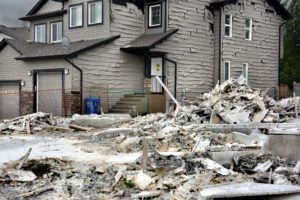
Some homes were burnt to the ground, while others, right next door, were left standing. Photo by Frank King, BGEA Canada
Most of the evacuees who have intact homes have returned to Fort McMurray, and the town has begun the long road toward recovery. There are even green shoots starting to sprout in the blackened forests surrounding the city.
The Federal Government has pledged $300 million to help Fort McMurray rebuild and the Provincial Government is providing $100 million, but both say there could be more funds on the way. Now it’s up to the residents to choose to stay, or find a new life somewhere else.
Those who lived in the Abasand, Beacon Hill and Waterways neighbourhoods face the toughest decisions. These three communities took the brunt of the damage, much of them laying in ruin. In late June, toxic ash was still fouling the air and toxins from burnt household chemicals had leached into the foundations. It is unclear when these communities will be safe for restoration.
But some residents are determined to start over, including Brian Jean, the leader of Alberta’s Wildrose Party. Jean is a long-time resident of the Waterways community and has already filed plans with the city to rebuild his home.
Other residents, like Martyn, are struggling with the loss of their treasured possessions and the decision to rebuild or start a new life somewhere else. As he stands by the shell of his former home, he talks to RRT chaplain Wanda Burchert.
“You’re helping us out, giving us a grasp of something to move on with,” Martyn tells her. “It’s heartwarming.”
Although Martyn is still uncertain about his future plans, he gratefully receives a Bible from Burchert.
“We serve a living God,” Burchert says, “He’s able to meet Martyn where he is.”
To find out more about these organizations, visit their websites:
The Billy Graham Evangelistic Association of Canada: www.billygraham.ca
Samaritan’s Purse: www.samaritanspurse.ca
The Salvation Army: www.salvationarmy.ca
Canadian Bible Society: www.biblesociety.ca.


